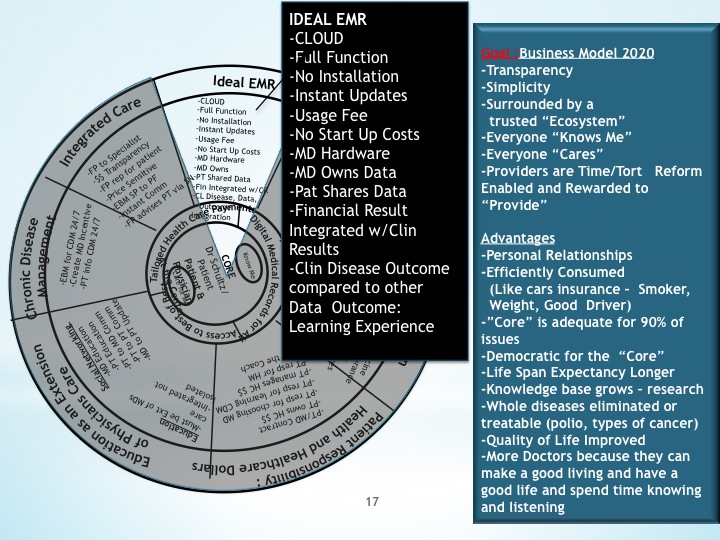The Shovel Ready EMR Project?
Stanley Feld M.D.,FACP,MACE
The Health Information Technology for Economic and Clinical Health (HITECH) Act passed in 2009 directed 5 % of the $800 billion dollar economic stimulus package towards digitizing medical records.
This was considered one of President Obama’s shovel ready projects. This project has lots of problems and was much less than shovel ready.
It was George W. Bush, not Obama, who started the project to digitize medical records. EMRs make sense if they are directed toward improving patient care.
President Obama funded the project with his shovel ready economic stimulus package in 2009. Physicians dislike the project. Patients find little value in the project.
It is estimated that in five years 50 times more health information will be generated and digitized than today. Diagnoses, treatments, DNA, medical images and vital signs already are being analyzed and stored.
One large problem is Americans don’t own their own healthcare information.
In its present form patients find little useful information in the EMRs. Many of the EMRs do not fit the Obama administration’s criteria of meaningful use EMRs. Medical practices will experience a penalty this year.
Government punishment hardly ever works. Government providing for innovative opportunities works.
The government and the insurance industry own the information.
The big data is derived from meaningful use EMRs. The government is only interested in evaluating the quality of physicians’ care. The government would like to decide on the reimbursement of that care.
The EMR has not added value to patient care because physicians have to spend too much time concentrating on filling in required documentation. Much of the information is worthless because they cut and paste template reports that are required documentation for the government to judge. The medical record is cluttered with information that is not useful.
The cost is physicians do not have time to relate to patients.
Michael F. Raab, M.D.Sanibel, Fla writes in the WSJ
“I recently received 147 pages of EMR which took me 30 minutes to review. I only found three lines that added new information.”
HIPAA (Health Insurance Portability and Accountability Act) requires hospitals, physicians, labs, pharmacies and other “covered entities” as well as the health plans and their “business associates” (for example, an information-technology vendor) to protect how your data. This rule applies only to paper record. It does not apply to digital records.
“Most EMRs aren’t covered by HIPAA at all, and providers and vendors can do whatever they want with your information.”
Digital records are vulnerable to hackers. Health records were stolen from nearly 80 million Anthem health-plan members. The façade of privacy has been exposed.
Electronic medical records companies, and hospitals and health systems that own physician practices own the patients’ digitized healthcare records.
These entities have withheld health information from patients in order to gain an edge over competitors. It becomes difficult for patients to switch to other healthcare plans or providers without their records.
Patients are entitled to their records but they must get past vendor delays.
There is great financial value of patients’ data beyond competitive advantages to these providers. The value is in marketing research for specific demographics. The revenue comes from using health information for drug research, targeted marketing and other efforts.
Many big data companies are investing heavily to own a piece of the multi-billion-dollar monetization of health information.
“These companies know that whoever controls health information will dominate the health-care marketplace and its vast profit pool.”
Congress has been slow to fix these problems. It needs to update health-information policy and privacy rules.
These are the four most important rules that Dr.David Brailer (the former national health information technology coordinator in the Department of Health and Human Services (2004-06)has outlined.
"1. Individuals should have unqualified ownership of their health information. Every person should be able to access his information whenever he wants, without blocking or delay.
1a. Health information should automatically follow patients wherever they get treated, unless they don’t want that to happen.
1b. Patients should be able to control which people and organizations are allowed to see their information, and whether those organizations can retain that information.
2. Individuals should be able to designate an intermediary to manage their information on their behalf. Many people would not want to handle their health information, so an “infomediary” could assist them and ensure that their information is used to advance their health status.
2a. Intermediaries could be a spouse, a hospital, a health plan, a pharmacy or even a tech company like Google, SalesForce or Yahoo.
3. Standards for security protection should be raised so that information is protected wherever it flows.
3a. A secure medical Internet—encrypted data lines that are walled off from hackers and other threats—is needed to protect the perpetual movement of information among hospitals, physicians and other legitimate data holders.
4. Every “covered entity” that touches health data, including every app, should follow the same rules."
Congress must act now!
The goal of the EMR was to have computers that could talk to each other for instant availability of patients’ medical information to enhance care and decrease retesting.
The availability of the $30 billion dollar Obama stimulus and the lack of consumer control has led to an evolving inefficient bureaucracy and rules and regulations that have created pain for the two most important stakeholders, patients and physicians.
The EMR project was not shovel ready as President Obama promised. It has turned out to be a waste of money. Instead of improving patient care it is hurting patient care.
An effective healthcare system would provide consumers with ownership of their healthcare data, their healthcare dollars and a desire to be responsible for their health.
The opinions expressed in the blog “Repairing The Healthcare System” are, mine and mine alone
Please have a friend subscribe
